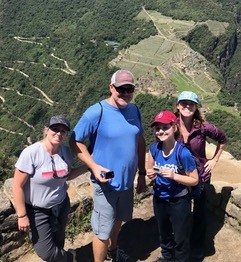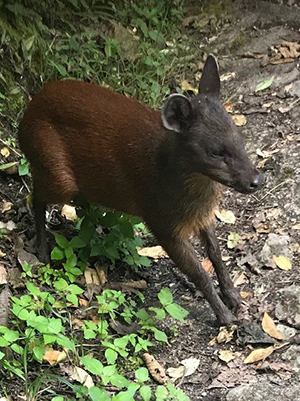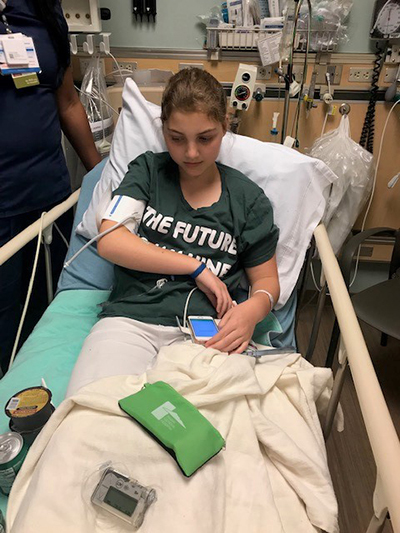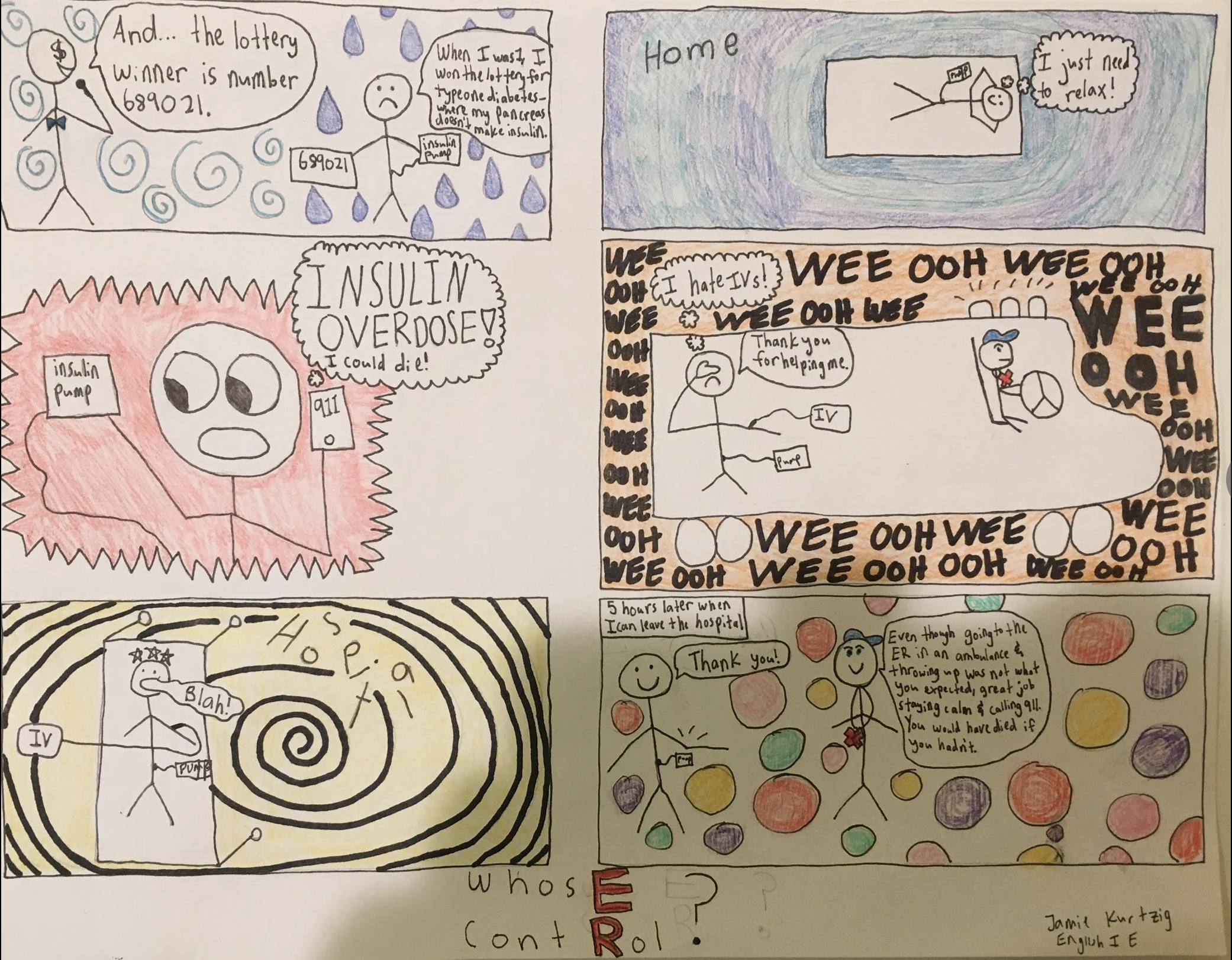Looping with Jamie – March, April, May 2019
After two years of sharing her experiences with the Medtronic 670G under the title “Diary of an Artificial Pancreas”, 14-year old Jamie Kurtzig has renamed her blog “Looping with Jamie”. In each entry, she will continue to write about her day-to-day experiences living with type 1 diabetes (T1D), now using the DIY app-based system that connects a continuous glucose monitor and an insulin pump to her phone to bring automated insulin adjustments.
March 2019
Lately, I have been having a lot of trouble with my Riley Link overnight. The Riley link is the small device that helps to wirelessly connect my phone, pump, and CGM. Whenever the Riley Link doesn’t work, this means that the loop can’t help correct my blood sugar numbers. My techie dad finally figured out that if we got 2 Riley Links and placed one on either side of my bed, then it works a lot better. This is because if one of them isn’t connected for a long time, then it switches to use the other one. This has really helped my parents get more sleep, and it has helped me to have better blood sugar numbers. It’s a win-win for now – fingers crossed it continues to stay connected at night.
In March, as the weather was changing, I had a cold for a little while, and I have discovered that the Loop does not do great at adjusting for this insulin resistance from my cold – bummer! This is my first “sick” while Looping. I am guessing the Loop technology helped more than no looping technology would have, but it did not do as well as I had hoped with these temporary high BGs. Loop algorithms need to do better with colds and prolonged high BGs. I was thinking that another way to solve this is to have a feature on the loop that lets it know to give more insulin. Currently, there is a button I can press to let the Loop know that I will be eating soon (it can raise my basals) and to let it know that I am exercising (it can lower my basals). This “cold” feature could be a nice feature for the future and even a “tummy” button for decreasing basals when the belly is feeling uncertain.

Today, I was playing around with Siri on the phone – just for fun I thought I’d ask some diabetes questions which I’ve never done. I just found out that Siri will actually respond to me when I ask for what my blood sugar is! It gets it from my diabetes phone apps! I think this is super cool, and it can be a super helpful tool for long distance athletes. Now is such an exciting time for T1D because we are making so many advances so quickly. I was talking with someone who has had T1D for a really long time, and they said that advances were not very frequent decades ago when they were growing up. The contrast for them between then and now was astonishing. This makes me feel so hopeful that scientists are closing the gap to a cure. I can’t wait!
April 2019
I am so excited to go to diaTribe today! I am going to spend a few hours at their office and experience this amazing company first hand. I have written an article for diaTribe about Looping that you can find here. I really love all of their articles and I learn so much from them. diaTribe works closely with DQ&A and Close Concerns, and they write about type one diabetes and all other types of diabetes and its related challenges. When I visited, everyone was really kind to me, and it seemed like they had put so much effort and attention into organizing a special day just for me and my mom. All of the employees seemed to really love their jobs and cooperate so well with each other. I even got to join one of their staff and idea meetings which was really cool for me. They brainstormed and planned and everyone participated and was heard. Everyone had a chance to share their opinions. I would like to work someplace like that!
Thank you so much, diaTribe for such an incredible day!

It is my Spring Break – yay! I am so excited to be in Peru with my mom and one of my best friends from middle school and her family! It will be my first time going to South America. We spent one day in Lima, a desert city that is the capital of Peru, and then we took a plane up to Cusco, the capital of the ancient Inca empire and a city near Machu Picchu. Lima is at sea level and Cusco is at 11,000 feet altitude. I was totally happy and healthy on the plane flight there and all day in Cusco, but at night, I could not stop throwing up because of altitude sickness! I even threw up water that I drank. I could not sleep at all, and I even had to try breathing with an oxygen tank. My mom also gave me some Ondansetron (Zofran) to help stop the nausea. Please always travel with this just in case! In the morning, my friend, her family, our tour guide, and especially my mom were super supportive of me. They changed our plans around so that I could get to a lower elevation as soon as possible without missing any highlights of the trip. The rest of the day, I tried to drink as much water and Gatorade as I could, while I relaxed in the hotel hammock next to an alpaca! I did end up throwing up this second night again even though we went down to 9,000 feet, but it wasn’t as bad that time. The next day, I was completely fine, so I think that the rest, liquid, medicine, and lower elevation really helped me. Looking back, I think that it would have been safer for me to have driven down to 6,000 feet or so from Cusco right after arriving at the high-altitude airport and then making my way up slowly to acclimate. I also should have taken the Diamox (WE HAD IT but did not take it until it was too late) – you are supposed to take it 48 hours before getting to high altitude to ward off the altitude sickness. (We brought Diamox, but I thought that I would be alright since I have gone to Tahoe with no problems, so we decided not to ingest it.)
Two days after I had altitude sickness, I hiked a part of the incredible Inca Trail to get to Machu Picchu. It was about 3 hours uphill in the hot sun, and that was definitely the hardest part for me. About an hour and a half after starting the hike, I had a low blood sugar. This was a little surprising to me since my blood sugars had been relatively stable despite the altitude sickness. I turned on the “exercise” button on my Loop app which reduces basals. We pulled over in a shady spot for some glucose tabs and electrolytes and juice and just sat down for 15 minutes and this all helped.

The rest of the hike was great, and we even saw an animal that my tour guide had never seen before on the Trail! It looked a little bit like a capybara. I climbed in the footsteps of the ancient Incans – what an incredible culture – and this was thrilling. My favorite part of the all-day hike, however, was getting to the Sun Gate where I could see Machu Picchu for the first time. It was so beautiful and even better than all of the pictures I had seen! I will never forget this trip.
When we returned from Peru, I got busy working on my Children’s Congress video: http://cc.jdrf.org/delegates/jamie-3/ Please watch the video on the bottom. It is about my story of living with T1D. I hope you enjoy.
Did you know that April is Celiac awareness month? Happy celiac awareness month! I know that this might not seem like something to celebrate, but I just wanted to remind you to inform people about celiac if they misspeak. Here are some things to know about celiac disease:
- We can’t eat gluten. Gluten is wheat, barley, or rye or anything cross contaminated with these items or derivatives of these items. Celiac is not a egg, dairy, lactose, or nut allergy.
- We have to be super careful about not having any cross contamination (like using the same toaster for bread with gluten and gluten free bread).
- Celiac is an autoimmune disease, so we are not being overly dramatic or trendy about our avoidance of gluten. It is necessary for us to eliminate gluten completely in order to stay healthy. I feel really sick whenever I accidentally eat gluten.
- Some things may say that they are gluten free, but they actually aren’t (because of cross contamination, not ingredients). I use the NIMA sensor to see what is gluten free or not. If something has a certified gluten free sign (a circle with a GF in it), it is gluten free.
- All whole food fruit and vegetables are naturally gluten free – yay! And Many proteins as well so long as we are careful about sauces, dressings, and coatings.
Thank you for being educated about this so you can know and help.
April 23 – one of the scariest days of my life

Today, I was taking my Stanford Online High School class peacefully at home when I happened to look at my Loop system. I saw that I had 19 units on board! (THIS IS A TON FOR ME!) I was really confused since I hadn’t given any boluses lately. I was reluctant to leave my class, at first, since I did not feel like I had a low blood sugar yet. My mom reminded me that this would be an emergency shortly. I started to eat a giant cereal bowl and drink soda, and my mom gave me a glucagon shot. After she thought about it a little more, however, she rushed me to our local fire station. I could not have possibly eaten that many carbs to balance out the 19 units in the amount of time that the insulin would drop me to a life-threatening state. I would have had to have ingested about 380 something grams of carbs in an hour to offset this accidental overdose and we did not think we could do this at home safely. Thankfully, our local fire station started me on D20 (basically a sugar water IV), and I rode with my mom in an ambulance to local emergency room. When I arrived, I felt extremely dizzy, I threw up, and I had to stay there for about 5 hours until I was stable, and the insulin had worked its way through my body. I needed Zofran again in my IV to help stop the throwing up. The situation really scared me. It worries me now that if I had not happened to look at my Loop system at that time, I might have died. I started to wonder how this insulin overdose had happened, and I remembered that I had been sitting in a massage chair before my class. I did notice that my insulin pump was vibrating, but I didn’t pay much attention since it buzzes all the time – every time Loop changes my basal rates. However, it also buzzes when it gives a bolus. I learned a lot: 1) Put my insulin pump on my belly (instead of at my back) when I sit in chairs, 2) Turn off the AUTO BOLUS feature on my loop pump (This is the button that was activated 19 times without me knowing it!) , 3) always have your limits set how you want them for your max bolus and daily dose and 4) when in doubt, head to the hospital where they can help you get better if things take a bad turn. I hope this never happens again!

Here is a video and presentation slideshow that I made for my Stanford Online Final project. I talked about how some teens living with type 1 diabetes do not want to tell others that they have diabetes. Click here for the video.
May 2019
I am so excited for my first ever concert as associate concertmaster of my orchestra! I play the violin and I love it. Before the concert, I remembered to turn off all of the alarms on my phone by turning my ringer off, and turning the volume off, turning do not disturb mode on. I also check to make sure my blood sugar number is in range before the concert and correct it if I need to. I keep my phone and glucose tabs on stage with me in a little purse in case I have a low blood sugar while I am on stage. I thought that turning all of this off would be enough to stop my phone from making any noises during the performance. However, I was wrong. It beeped, luckily when I was offstage, but it really embarrassed me. I just powered my phone off, but this wasn’t a very good idea because my Loop system can’t work when my phone is powered off. The concert went really well for me, but I was embarrassed by this part. I will have to learn more about turning my phone on mute for future performances since what I did didn’t work.
Hope Gala: Aloha from the 2019 Hope Gala! I am so excited to attend the Hope Gala. I loved all of the beautiful decorations in Hawaiian theme, and I was so happy to see such amazing people all around – my doctors, my care team, my T1D Marin friends, and all of the generous supporters in the room. The fund-a-cure speech by the Tobin kids was so good, and I even know one of them since we fence together! It was a great night, and I had such a fun time.

I HAVE SO MUCH HOMEWORK! I am so stressed out, and my T1D is now the least of my worries. Even though my school doesn’t have finals, I am completely overwhelmed with homework, tests, quizzes, projects, etc. I do acknowledge that I haven’t had the best time management skills, so I could have improved this. I need to learn more for next year. For any students reading this, hang in there! Summer is coming!
With Gratitude and Aloha,
Jamie